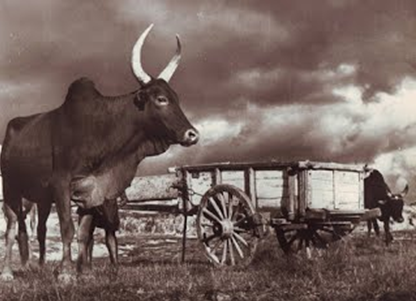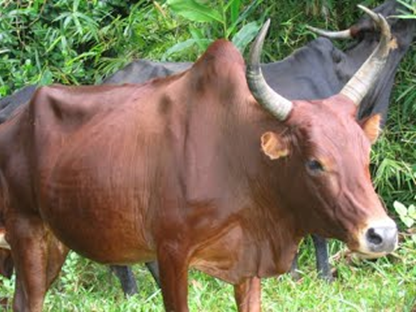Madagascar Zebu
Madagascar Zebu
Madagascar Zebu
Descendant of an Indian species of aurochs, native of Africa, the Malagasy zebu is characterized by long horns, a fat bump at the level of the tourniquet and a great extension of the skin under the chin. In the old days symbol of the royalty, the animal remains omnipresent today as well in the daily life of the Malagasy as for the event-driven periods and even in his next world life. Today, the culture of the zebu persists, would be this only partly. Many Malagasy people place their capital in the zebu. To own is synonym of success in the social life, in particular in rural environment. The bull with long horns is still reproduced on bank-bills and coins.
Symbol of power, prosperity and wealths
The ox with bump was introduced into the big Island at the time of migrations waves from Africa. Its name comes from the word kiswahili “gnombe”, so that in certain dialects, we call it “aombe” or “agnomby”. The history tells that in the kingdom merina, it took its name of “omby” only under the reign of Ralambo (1575-1610). Indeed at the time of one of his displacements with Ambohitrabiby, king Ralambo saw “jamoka” (oxen) about to perish because of their lard. He gave the order to the one of his slaves to taste the meat of it. Attracted by the odor of the grill and the flavour of the “trangitrangy” or bump which was “matrafotrafo” (delicious), he ordered to his men to gather these animals in a park. Arrived at home and dry, they cried out “omby E, omby E! ”, which wanted to say “it is sufficient, all is there!”. From this moment, the name of “omby” was adopted. On the central Highlands, contrary to the other areas, we consumed beef only as from this moment. Today, most Malagasy dishes are with meat of ox, such the famous “kitoza” or “varanga”. Regarded as one of the best pieces with the bump, since Ralambo, the vodi-hena (the backside), is intended to the king. The one who infringes this rule will see his wife and her children reduced to slavery. Since, we keep this part for the parents and the groins.
The zebu represents the power and prosperity. Allured by this aspect, the kings made their symbol of it. In Mahazoarivo Isandra (Fianarantsoa) draws up a raised stone with five zebus, with the image of the five kings who followed one another the throne during one century and half. The three, turned towards the South, are long horns and high bumps. They represent kings Ralambovitaony (1710-1730), Ramasimbanony (1730-1750) and Andriambetany (1750-1790) who, from their power, made prosper the kingdom of Isandra.
The fourth, still directed towards the South, has horns and a less bump, incarnates Andriamanalina II (1790-1796) whose reign was marked by a decline. The last, turned towards North, corresponds to Andriamanalina III, who bound by blood with the king Andrianampoinimerina. Sovereignty lost all its power in this period, also the fifth zebu had hardly horns and a bump. Andrianampoinimerina, “the ombalahibemaso”, was a great powerful king, intelligent, who took the long view.
But the zebu does not remain only a symbol. It is used as reference. The young Betsileo or Merina measures his strength with the zebu’s force by practising the “savika” or the “tolon’ omby”. This violent and dangerous sport, like the bullfightings but without killing, still practised nowadays, pleases the population enormously. The young men especially take part in it in order to allure their beloved. Bara, as for them, show their virility through the ox stealing.
For the alives and deaths
The possession of a large herd symbolizes the power and the wealth. And for a proposal of marriage, a young Bara must bring with the lucky girl with a zebu “mazavaloha”, which will be sacrificed if the negotiations lead to engagement. For any event in general, the fortune of a family is estimated to the number of shot down oxen. For Antandroy, the breeding is rather contemplative and the herd has not another utility except the funeral. The Reverend Callet in “the History of the Kings” evokes that if the Malagasy people immolate oxen, it is because they think that the shade of death pushes in front of those of the zebus, towards the place where the deceased go. To kill oxen so that their shades are carried by death, it is to return the honors of immolation of the animals. The shade of the died person to whom we devote these ceremonies, will keep the herd where the hearts are wandering, i.e. in Ambondrombe (to 45 km east of Ambalavao, Fianarantsoa). Thus, for Bara, very attached to its animals, his only desire, to his death, is to carry at least a zebu to his death. For Antandroy, we exterminate all the herd of deceased during the wake which can last for weeks, and even of the months. The head of these animals will decorate the tomb. In the same way, for Mahafaly, heads of zebus and “aloalo” decorate the tombs. The “aloalo”, sculpture telling the life of the deceased, present the drawing of zebus if he had some during his life.
On the Highlands, we kill three, four oxen or more, according to the fortune of the person. The horns are suspended on a long pole which we plant close to the tomb. People who pass close to these buildings will be able to have an idea of the wealths of the dead. The meat is distributed to all the population. During the burial, other oxen are also cut down for the purification and the “ leave” of the deceased. And still all the way along the route of the funeral convoy. Thus, on the death of the queen Ranavalona I, we immolated zebus during the passage of the funeral convoy until Ambohimanga. Arrived on the scenes, 3000 animals were still decapitated. If the population were not satisfied, the family may find it beneficial to make up for it after mourning. It is the “fiefana”.
But the most attractive in the Malagasy culture of the zebu, it is its spiritual value. Almost in all the island, it is selected like animal of sacrifice. Moreover, it is used for the ceremonies as purification. A union incest will be regularized by the “fanalana ondrana” by killing a zebu which cut head and tail will be placed inversely. The rum, which translates the vicissitude of the life, and the ox appear in any meal of communion of alive and deaths. Called upon during the “joro”, the ancestors are present and take part in the festivities.
Madagascar Zebu. Real Estate Madagascar. Madagascar Zebu. Real Estate Madagascar. Madagascar Zebu. Real Estate Madagascar. Madagascar Zebu. Real Estate Madagascar.





